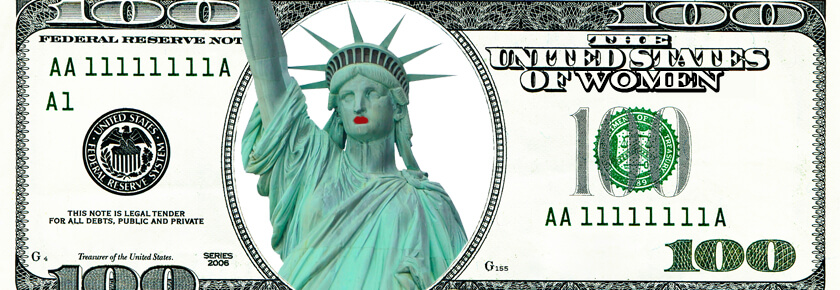
Women control 73% of consumer spending. That’s more than enough to create a more female-friendly workplace.
This article was made possible because of the generous support of DAME members. We urgently need your help to keep publishing. Will you contribute just $5 a month to support our journalism?
Sure, women still have a long way to go to achieve fair pay, family-friendly workplaces, and equal representation in the executive ranks.
But we’ve also come a lot further than we may realize. It turns out that all those years of balancing careers and households left women with a powerful economic weapon that may help achieve those unrealized goals: Purchasing power.
According to a Harvard Business Review report, while men still dominate business leadership — holding 86 percent of Executive Officer positions at Fortune 500 companies in 2012 – it’s women who control $4.3 trillion of the $5.9 trillion in U.S. consumer spending that keeps companies afloat.
For decades, women have fought for gender equality through legal channels with mixed results. But imagine if we harnessed the power of the purse. After all, if you combine women’s purchasing power with their earning power, along with ownership of 30% of America’s businesses, women are the largest single economic force in the world – so says the U.S. Women’s Chamber of Commerce (USWCC).
So why hasn’t that purchasing power translated into actual workplace and business influence?
Margot Dorfman, founder and CEO of the USWCC, says the first obstacle is awareness.
“This has to be a mindset,” she says. “If everyone who was committed to economic growth for women purchased from women-owned firms first and women-friendly firms second, we’d see a change not just in the growth of women-owned firms, but also in the growth of the American economy.”
We’ve already seen some glimmers of how purchasing power can effect social change. In April, the activist group UltraViolet forced Reebok to sever its relationship with musician Rick Ross who had rapped about date rape. UltraViolet’s online petition received over 50,000 signatures. But to truly harness women’s purchasing power requires broad coordination and leadership which doesn’t yet exist (though the USWCC hopes to change that).
Another obstacle is the economy’s current response to women’s purchasing power – that is, to target women as consumers, not market leaders. When women struggle for balance and equity, the response of a male-led economy is to sell us a time-saving product, rather than change the underlying workforce issues that cause those problems in the first place.
And a further issue is the difficulty that women have figuring out which companies they should be supporting and which they shouldn’t. All too often, a company’s marketing can be deceptive. “Female friendly ad campaigns with ‘happy headlines’ don’t always match a company’s internal business practices,” says Dorfman. “There’s usually a story behind the story.”
Take WalMart, for example, which announced a record increase in its use of minority and women-owned suppliers in 2010. But even with the increase, WalMart still did less than two percent of its annual spending that year with minority and women-owned firms, according to Dorfman’s USWCC report, The Women-Led Economy.
The report states: “Women must stop reacting like a target market and begin leading as a mature, major market force… acting together to protect our interests.”
But as the Walmart example illustrates, it’s not always easy to know who the good guys are. In addition, women-owned businesses are typically small, and not always easy to find. Although census data shows the number of women-owned businesses grew 44% from 1997 to 2007, their receipts were actually less than 4% of all business receipts nationwide.
One of the reasons that women-owned businesses haven’t gained enough ground in our economy is because they face unique challenges when it comes to resources. “They don’t have fair access to government contracts, and they don’t have fair access to capital,” Dorfman says.
As a result, women typically rely more on credit cards and home equity to fund their ventures, draining their assets and putting their families and retirements at greater financial risk – yet another obstacle to women’s economic leadership.
It’s a goal worth chasing. If women used their purchasing power to support women-owned and women-friendly businesses, those firms would in turn be able to promote female-friendly business practices as they grow and hire. The culture would change. “Employees at firms that don’t provide fair pay and family-friendly work environments are going to jump to the other firms that are,” says Dorfman.
One step in the right direction. The USWCC is launching its new Women’s Marketplace Mall this summer, which will provide online storefronts for women-owned firms in one convenient location. Women’s enormous purchasing power could be one of the greatest potential disruptors of a male-led economy.
All we have to do now is stop letting other people tell us how to spend it.
Before you go, we hope you’ll consider supporting DAME’s journalism.
Today, just tiny number of corporations and billionaire owners are in control the news we watch and read. That influence shapes our culture and our understanding of the world. But at DAME, we serve as a counterbalance by doing things differently. We’re reader funded, which means our only agenda is to serve our readers. No both sides, no false equivalencies, no billionaire interests. Just our mission to publish the information and reporting that help you navigate the most complex issues we face.
But to keep publishing, stay independent and paywall free for all, we urgently need more support. During our Spring Membership drive, we hope you’ll join the community helping to build a more equitable media landscape with a monthly membership of just $5.00 per month or one-time gift in any amount.


















































































